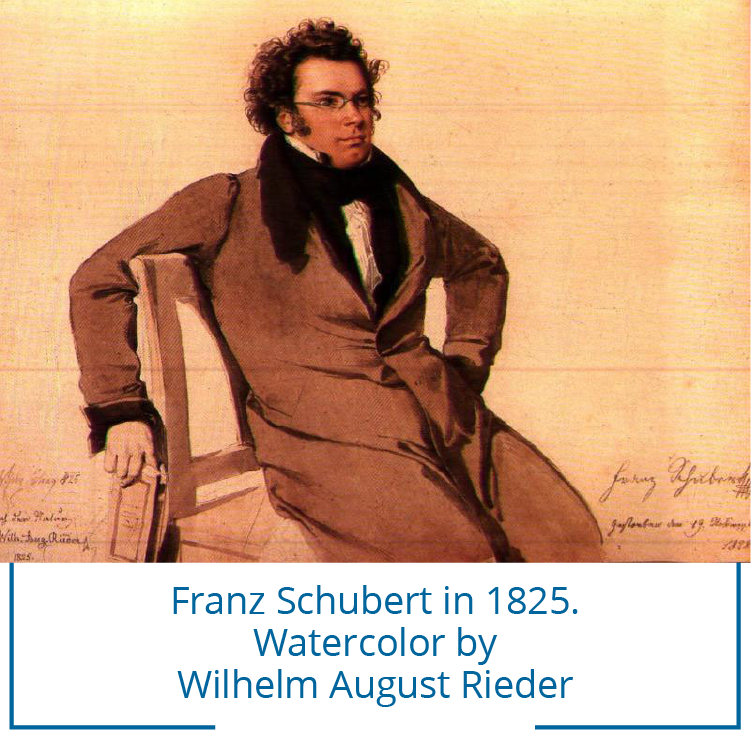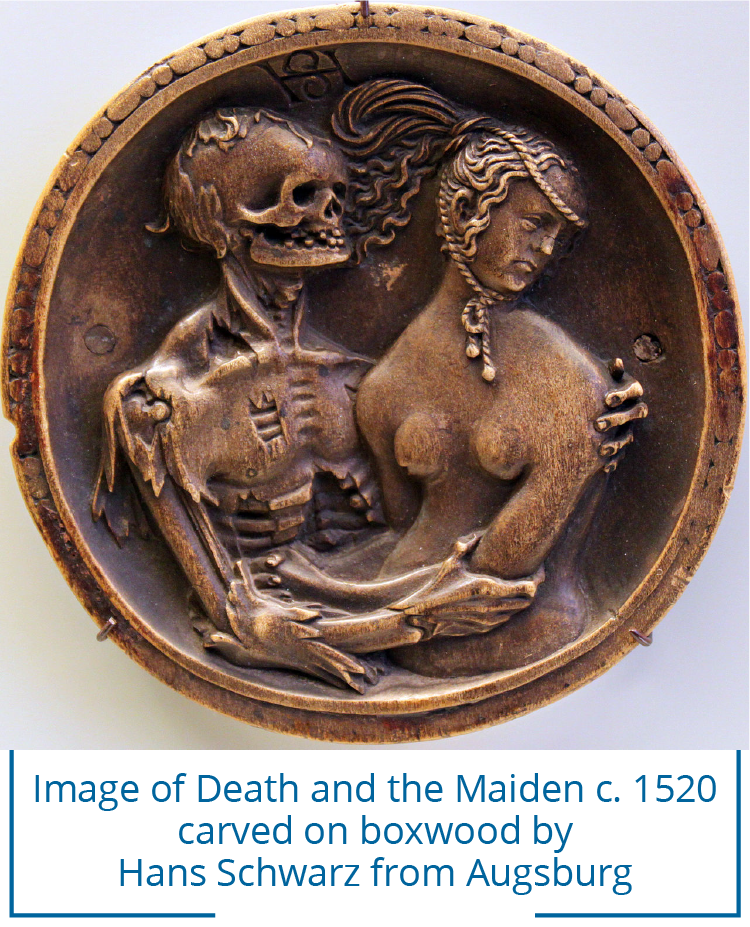STRING QUARTET IN D MINOR, D. 810 (DEATH AND THE MAIDEN)
Franz Schubert
(b. Vienna, Austria, January 31, 1797; d. Vienna, November 19, 1828)
Composed 1824; 40 minutes
 The powerful image of Death as a friend whose hand gently and unrelentingly approaches, caresses and claims a maiden goes back to at least medieval times. Schubert found the image in the poem Der Tod und das Mädchen (Death and the Maiden) by the German poet and essayist Matthias Claudius (1740–1815). He set this to music as a song in 1817. Its haunting piano accompaniment contains an insistent long-short-short rhythm whose ominous onward tread becomes a rhythmic death motif to which Schubert sets only music sung by Death itself. Seven years later, the rhythmic motif became the emotional heartbeat of the slow movement of a new string quartet. But the evocative rhythm also underlines the other movements of his dark and urgent quartet, giving it a unity of purpose and design that is unmatched.
The powerful image of Death as a friend whose hand gently and unrelentingly approaches, caresses and claims a maiden goes back to at least medieval times. Schubert found the image in the poem Der Tod und das Mädchen (Death and the Maiden) by the German poet and essayist Matthias Claudius (1740–1815). He set this to music as a song in 1817. Its haunting piano accompaniment contains an insistent long-short-short rhythm whose ominous onward tread becomes a rhythmic death motif to which Schubert sets only music sung by Death itself. Seven years later, the rhythmic motif became the emotional heartbeat of the slow movement of a new string quartet. But the evocative rhythm also underlines the other movements of his dark and urgent quartet, giving it a unity of purpose and design that is unmatched.
That said, by no stretch of the imagination could the quartet itself claim to be about Death. There’s much in it about life, too. The opening movement is virtually without theme. Its fierce opening triplets encourage melodies to appear. But they are not the long lyrical lines we customarily associate with Schubert. Both the scale of the music and its sonorities are orchestral. The themes confront one another. The quiet, bittersweet closing of the slow movement contrasts sharply with the driving syncopations of the Scherzo. This powerful, tightly constructed movement had its origins in an unlikely source: a G-sharp minor dance for keyboard (D. 790). To the dance, Schubert added the rhythm associated with Death. It reflects Schubert’s interest in cyclical unity within the quartet rather than any preoccupation with stretching the image of Death into another movement. The finale returns to motives from the first movement and its saltarello-like rhythm propels the music forward with tremendous energy and brilliance. The minor key prevails not only through the five variations of the slow movement but throughout the entire work.
It was probably a shared fascination with youth, beauty and both the terror of death and its comfort as a release from the troubles of the world that drew GUSTAV MAHLER (1860-1911) to Schubert’s quartet. His arrangement adds tone, color and weight to the original by adding a line for double basses, by occasionally dividing the violins or doubling cellos with violas, and by making striking use of mutes in the slow movement. The resulting richness of the orchestration adds to the bittersweet quality of Schubert’s quartet writing. It also adds an undeniable element of surprise to those familiar with Schubert’s string quartet – though present-day listeners will perhaps be less shocked than were the German critics when Mahler first conducted the slow movement to a half-empty hall in Hamburg in 1894. Because of criticism that he was depriving what was then regarded as Schubert’s ’divine’ music its natural intimacy, Mahler never gave a full performance of his arrangement. However, he did notate his score with his full performance intentions and even began work on arranging some of the other Schubert quartets.
These arrangements were known to have existed for many years. But they were, for all intents and purposes, lost. However, as recently as the early 1980s, Mahler’s daughter Anna was looking through some of her father’s scores and came across a bound volume of Schubert’s string quartets. Some fastidious pencil markings caught her attention and caused her to seek advice from Mahler experts David Matthews and Donald Mitchell. That advice confirmed the rediscovery, and Mahler’s arrangement was published in 1984.

|
Der Tod und das Mädchen Das Mädchen: “Vorüber! ach, vorüber! Geh, wilder Knochenmann! Ich bin noch jung, geh, Lieber! Und rühre mich nicht an.”
Der Tod: “Gib deine Hand, du schön und zart Gebild’, Bin Freund und komme nicht zu strafen. Sei gutes Muts! Ich bin nicht wild, Sollst sanft in meinen Armen schlafen.” |
|
Death and the Maiden The Maiden: Pass me by! Oh, pass me by! Away, cruel man of bones! I am still young, go, please leave me, And do not touch me.
Death: Give me your hand, you lovely, tender creature. I am a friend, and come not to punish. Be of good courage! I am not cruel, Softly shall you sleep in my arms! |
– Matthias Claudius (1740–1815)
